Libya
![]()
The title of this article is ambiguous. For other meanings, see Libya (disambiguation).
Template:Infobox State/Maintenance/TRANSCRIPTION
Template:Infobox State/Maintenance/NAME-German
Libya ([ˈliːbi̯ən]/[ˈliːby̆ən]/[ˈlyːbi̯ən]; Arabic ليبيا Lībiyā [ˈliːbijaˑ] ![]() , officially Arabic دولة ليبيا, DMG dawlat Lībiyā 'State of Libya'; Berber ⵍⵉⴱⵢⴰ Libya) is a state in North Africa. Its northern border is the Mediterranean Sea (Mediterranean littoral state); it borders Egypt and Sudan to the east, Niger and Chad to the south, and the Maghreb states of Tunisia and Algeria to the west.
, officially Arabic دولة ليبيا, DMG dawlat Lībiyā 'State of Libya'; Berber ⵍⵉⴱⵢⴰ Libya) is a state in North Africa. Its northern border is the Mediterranean Sea (Mediterranean littoral state); it borders Egypt and Sudan to the east, Niger and Chad to the south, and the Maghreb states of Tunisia and Algeria to the west.
Libya had a population of about 6.8 million in July 2018. In addition to Tripoli, which is home to millions and the capital, there are other large cities such as Bengasi, Misrata, Tobruk and Sabha.
Since 1835, the territory of Libya was part of the Ottoman Empire as the province of "Tripolitania"; before that, various conquerors controlled only the coastal areas of Tripolitania and Cyrenaica, but not their hinterland and the Fessan. From 1911 to 1932, Italy fought two colonial wars over the territory, with Benito Mussolini's fascist regime committing genocide in Cyrenaica from 1929 to 1934. Subsequently, the colony of Italian Libya was established in 1934 and remained under Italian control until 1943. Libya finally became a sovereign state in 1951 and was a kingdom until 1969. In 1969, Muammar al-Gaddafi came to power in a military coup. In February 2011, his dictatorial rule began to crumble; a Libyan civil war began. From March to October 2011, international military intervention sided with Gaddafi's opponents. Ruler Gadhafi was killed by his opponents on October 20, 2011. In May 2014, a second civil war emerged from the power vacuum, with rival militias fighting each other, leading to political and economic collapse and the division of the country into western and eastern spheres of power. On Dec. 17, 2015, a peace agreement was reached between the rival camps from Tobruk and Tripoli that provided for the rebuilding of the state and its institutions and a unity government under Fayiz as-Saraj by 2018. However, even after the peace deal, Libya remained divided into a western part of the country supporting as-Saraj and an eastern part with the capital Tobruk, where Khalifa Haftar has great influence. In addition to the power struggle between the two halves of the country, the terrorist organizations Islamic State and al-Qaeda operate as a result of the power vacuum that has been created.
Libya is considered a transit country for many African refugees and migrants to Europe. Thus, several hundred thousand people from other African states are said to be in the country, subjected to crimes such as murder, assault and rape, and slavery, and often held in shelters similar to concentration camps.
Geography
The northwestern part of Libya, known as Tripolitania, is occupied by the coastal plain of al-Jifara, the mountainous stratified plain of Jabal Nafusa (up to 968 m) and the adjacent rocky desert of Hammada al-Hamra. A steep step to the south leads to the sand, gravel and scree deserts of the Fessan.
The middle section includes the coastal Syrte Basin, which is rich in oil and natural gas deposits. In its hinterland rises the volcanic massif of al-Charuj al-aswad (1200 m).
In the northeast lies the Kyrenaika with the karst mountains of al-Jabal al-Achdar (878 m), which drop steeply to the sea. Across the Mediterranean Sea to the north, Libya neighbors Italy (Sicily and Pantelleria), Malta and Greece (Crete). The Bay of the Great Syrte is claimed by Libya as territorial waters. The karst mountains merge eastward into the steppe of the Marmarika, and southward into the sand dune sea of the Libyan Desert. In the border region with Chad, the northern foothills of Tibesti, with the country's highest mountain (Bikku Bitti 2,267 m), encroach on Libya.
Libya is the fourth largest country on the African continent in terms of area, after Algeria, the Democratic Republic of Congo and Sudan.
Drinking water supplies
In total, a good 85 % of Libya's land area is occupied by the Sahara. Only about 2 % of the land is currently arable. Libya is one of the few countries in the world where there are no permanent rivers, but rather so-called wadis, which only carry water temporarily after heavy rainfall. However, there are freshwater reserves of 35,000 billion cubic meters under Libya's national territory, which is far above the water volumes of Lake Baikal or the Great Lakes of North America. See also: Great Man-Made River Project.
Climate and vegetation
In the Mediterranean-style winter-humid coastal area, mean temperatures are 12 °C in January and 26 °C in August; mean annual precipitation here is 300 mm. In spring and fall, a dry-hot dusty desert wind, the gibli, often blows. The interior has a desert climate with considerable temperature fluctuations (below 0 °C in winter, above 50 °C in summer) and almost no rain.
Despite the size of the country, Libya's climate has only two main characteristics: a subtropical warm climate zone along the coast and a hot, dry desert climate zone in the interior (the vast majority).
The narrow coastal strip on the Mediterranean is dominated by mild winters with some rainfall. On average, it receives 250-400 mm of precipitation per year, which corresponds to about 30-50 rainy days, which occur almost exclusively from November to February. Temperatures during this period are 8-12 °C at night and 16-20 °C during the day. Spring is warm, with values between 12 and 16 °C or 20-28 °C, almost without precipitation. This is also the time of hot sandstorms (Gibli) from the south, which can bring peak temperatures of up to 43 °C even in April. Summers are long, very dry and hot with average daytime temperatures of 30-33 °C. At night, temperatures usually drop to around 20-22 °C. Autumn is warm and somewhat humid towards the end with daytime and nighttime values of 22-27 and 13-16 °C, respectively. Gibli can occur again at this time, causing heat waves of 40 °C. Humidity is high throughout the year at 60-75%. The climate just described also applies to cities such as Tripoli (the capital), Misrata, Surt, al-Baida and Benghazi.
The steppe and desert areas, which begin shortly after the coast, are characterized by mild winters and very hot summers. Precipitation is almost non-existent throughout the year (0-5 days of precipitation or 1-35 mm of rain). In winter, temperatures range from a warm 18-24 °C during the day, dropping to cool 3-8 °C at night. In some areas light frost is quite possible. Humidity is average at 35-55%. Spring and autumn are very warm during the day (24-35 °C, although it can get hotter), while nights remain cool (10-18 °C). Sandstorms are frequent, sometimes reaching the coast. Humidity decreases in spring and increases again in autumn. Summers are very hot with dry air (only 20-30 % humidity). Average daytime temperatures are 38-42 °C, with nights between 20 and 26 °C. The Libyan desert areas are considered to have the highest temperatures ever recorded in the world, reaching up to 58 °C. In the city of Ghadames on the Tunisian border, the highs for a full five months (May to September) are 50 °C and above. The desert climate applies to cities such as Ghat, Ghadames, Kufra and Sabha, which have very similar climatic conditions despite their distances from each other.
Flora and fauna
The coastal mountains have Mediterranean flora, and the coastal lowlands have steppe vegetation. The fauna includes the typical species of the arid regions, such as dune gazelles, hyenas, jackals, desert jumping mice, and desert foxes (fennecs), as well as anubis baboons, wild asses, hares, and hawk cats, and various birds of prey, snakes, and scorpions. Between 1990 and 2000, the population of game increased by 1.4%. In 2009, 141 species of grasshoppers were counted.

Capital Tripoli on the Mediterranean Sea
Population
In 1960, Libya had less than 1.5 million inhabitants. Since 1975, the population has increased from 2.5 million to 6.2 million (2012, estimate). In 2005, 30 % of the population was under 15 years of age. About 90% of the population lives in the coastal areas of Tripolitania and Cyrenaica, 85% of which live in cities. Approximately one to two million guest workers were employed in the country until the outbreak of civil war. Life expectancy averaged 71.6 years in 2010-2015 (68.8 years for men and 74.4 years for women).
Ethnic-cultural groups
In 2011, 97 % of the population consisted of culturally and linguistically Arabized Berbers and Arabs, as well as linguistically unassimilated Berbers. With the Islamic conquest of the country, a large part of society was gradually Arabized; Berbers living in their traditional tribal societies now make up only about 25 % of the population.
The Arab population is in turn divided into several distinct groups, usually referred to as "tribes". Only 5% of the population are still nomads.
Parts of the Berber nomadic Tuareg people live in western Libya, and numerous Tubu live in the south. Under Gaddafi, the latter were partially expelled from their residential areas and their citizenship was revoked. The reason given was their supposed origin in Chad. There are also Italians, most of whom were forced to leave the country after 1969. Other minorities include Greeks, Turks, Kurds and Levantines, as well as Maltese, Egyptians, Tunisians, Indians and Pakistanis. The Jews, who had been resident on the coast for thousands of years, were driven out of the country after the Tripoli pogrom in 1945.
Languages
The majority of the population speaks the Libyan Arabic dialect as their mother tongue. In addition, the Berber languages Nafusi (220,000 speakers), Ghadamsi (42,000 speakers) and Tamascheq (40,000 speakers) as well as the Nilosaharan Tubu language Tedaga (2,000 speakers) are spoken as minority languages.
High Arabic has been the only official language up to now. Beginning in 1969, a nationalist campaign for Arabization was launched under Gaddafi, which was intended to oust Italian as a foreign language and the Berber languages from public life. A new decree required that all street signs, storefront signs, company signs and traffic passes be labeled in Arabic. Since the 1980s, almost only Arabic has been understood. Under Gaddafi, foreign language instruction was banned in schools, and only the theory and history of foreign languages could be taught at universities.
In addition to High Arabic, the transitional government also permitted the respective Berber languages as official languages.
Religion
Islam is the state religion. The free practice of religion was guaranteed under Gaddafi, as long as it did not conflict with tradition. State and religion had been separated until then, and clerics were restricted to religious affairs. The People's Republic government presented itself as pro-women in its programmatic statements. Under it, coeducation was practiced, but the introduction of compulsory military service for women and the admission of females to military academies shocked the Islamic male society. Gaddafi accordingly clashed with strict imams, persecuted radical preachers and attempted to modernize traditions to his liking. Sufi communities, persecuted in some other Islamic states, were able to practice openly.
The Senussi are a religious brotherhood with a secular claim to power in Cyrenaica. They fought against the Italians from 1911 and against the British from 1943. From 1951 until the revolution of 1969, it provided the king. In recent years, there has been an increased turn to orthodox Islam throughout the country; the veiling of women is on the rise. Since the 1980s, underground groups such as the Muslim Brotherhood, at-Takfir wa-l-Higra, Hezbollah, al-Jihad and their religious tendency to hijack politics have been described as an Islamist threat to Libya. Since the mid-1990s, the Libyan Islamic Fighting Group has also been active, especially in Cyrenaica.
97 % of the population are Sunni Muslims, predominantly Malikites. The majority of the tradition-conscious Berber tribes belong to the special Islamic community of the Ibadites. There are still about 74,000 Catholics in Libya, some Coptic and some Greek Orthodox Christians. Most Christian churches were closed after Gaddafi came to power in 1969. The descendants of the approximately 7,000 Jewish Libyans who remained after the 1948 pogroms emigrated after the Six-Day War.
See also: Christianity in Libya
Refugees
Libya is considered a transit country for many African refugees and migrants to Europe. The European Union, through the European Union Emergency Trust Fund for Africa, is working with IOM and UNHCR to reintegrate refugees in Libya, along the central Mediterranean route, and in Ethiopia. According to UNHCR data, a total of 43,113 refugees and asylum seekers were registered by UNHCR in Libya as of October 2017.
The situation in Libyan refugee camps is portrayed in the media as catastrophic. There are twelve disembarkation points in Libya for people picked up at sea, where they are cared for by the UNHCR.
See also: Aid measures for refugees on an EU basis
See also: Refugee crisis in Europe from 2015#Libya
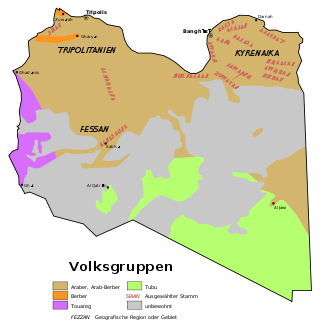
Ethnic map of Libya

Population development in millions of inhabitants
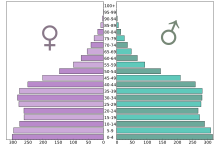
Age pyramid in 1000 inhabitants
Social system/education
Libya had one of the highest per capita incomes on the African continent. Social security for residents included free medical care and widows', orphans' and old-age pensions. General schooling is compulsory for six- to fifteen-year-olds. Nevertheless, the illiteracy rate for women is still 14.4 % and for men 3.3 %; however, at 9 % overall, this rate is very low by African standards.
There are universities in Tripoli, Benghazi and other larger places.
See also: List of universities in Libya
Although Gaddafi held conservative Islamic views on the role of women, in striking contrast to other Arab socialists, women under his rule in Libya were highly educated compared to other Arab countries. In the event of divorce, they were allowed to keep the joint house or apartment. There were daycare centers for working women, as well as women in classic "male professions" such as policewomen or pilots. In 1979, Gaddafi established a military academy for women. However, most educated women worked in health care and as teachers, and the female employment rate was less than 10 % in the mid-1990s. Polygamy remained permitted in Libya, unlike in neighboring Tunisia; the man only had to obtain permission from the other wife to marry a second wife. Also, in most cases, the spouse was chosen by the family.
The Libyan government has paid $140 million to Jordan for medical treatment of Libyans injured during the civil war; as of early February 2012, some 15,000 injured Libyans were receiving treatment there.
Politics
| Political indices | ||||
| Index name | Index value | Global rank | Interpretation aid | Year |
| Fragile States Index | 95.2 from 120 | 20 from 178 | Stability of the country: Alarm | 2020 |
| Democracy Index | ▼1,95 from 10 | ▼158 from 167 | Authoritarian regime | 2020 |
| Freedom in the World | 9 from 100 | --- | Freedom status: not free | 2020 |
| Press Freedom Ranking | 55.77 from 100 | 164 from 180 | Very serious situation for press freedom | 2020 |
| Corruption Perception Index (CPI) | ▼17 from 100 | ▼173 from 180 | 0 = very corrupt / 100 = very clean | 2020 |
Political system
In August 2012, the General National Congress replaced the National Transitional Council (Arabic المجلس الوطني الانتقالي, DMG al-maǧlis al-waṭanī al-intiqālī), which was founded by insurgents on February 27, 2011, as the supreme organ of the state. Since the fall of long-time ruler Muammar al-Gaddafi, large parts of the country have been under the control of militias that did not submit to the National Transitional Council.
Elections to the General National Congress were announced as recently as August 2011 and were held from June 18 to July 5, 2012. 2,501 candidates applied for the 200 seats. Subsequently, Mohammed Yusef el-Megarief was elected president. On September 13, 2012, Mustafa Abu Schagur was elected prime minister.
According to the electoral law on the constituent assembly adopted in Tripoli on January 29, 2012, 136 of the seats were to be allocated to candidates from political parties and 64 seats to independent candidates. In the 2012 election to the Libyan National Congress, approximately 60 % of the votes, 120 out of 200, were awarded to independent candidates and not to party lists.
Several political parties were founded in the process. However, they were not allowed to accept money from abroad. Likewise, former Gaddafi supporters were prohibited from running for office. A law that went into effect on May 3 prohibited the formation of religious parties.
In the election at the end of June 2014, only independent candidates and no party lists were allowed in order to prevent political infighting in the future. As a result, many Libyans hope that this will be another step toward democratizing the country. The new 200-member parliament, the Council of Deputies, took over legislative powers on August 4, 2014.
The compulsory military service for men and women between the ages of 18 and 35 that existed in Libya under Gaddafi has effectively been abolished. The new transitional government has not yet issued any regulations on compulsory military service.
See also: List of Heads of State of Libya, List of Prime Ministers of Libya and High Council of State.
Legal system
Since the end of the civil war, Libya's legal system has been in an unclear state; Libya has not had a constitution since 1978, and a new one has yet to be adopted. The UN mission UNSMIL is to provide assistance in establishing a legal system and an administration based on the rule of law. The establishment of a new, generally recognized judicial system is dragging on. Torture is again being used in prisons, primarily those not under the control of the transitional council. The civil code in effect until the civil war followed Egypt's and was therefore, like the latter, influenced by the French legal system.
The legal basis of the Libyan constitution was the Koran (Article 2). Islamic law (Sharia) applied to personal, family and inheritance law (1984 law) and, since 1994, to criminal law. Homosexuality had been punishable since 1973 (Law No. 70/1973). Zinā (adultery and fornication) was punishable by 100 strokes of the cane under Law No. 70/1973; slander for fornication/adultery (qadhf) was also punishable. The reason given was to curb prostitution.
According to a defense lawyer in Benghazi in February 2012, the militias had too much power. Of 50 defendants charged with "high treason against the revolution," only three were able to testify in person at the hearing. For the remaining 47, the militia refused to bring them into the courtroom; "security problems" were cited as the reason. Torture of defendants has also been reported.
In December 2013, Libya's National Assembly voted to introduce Sharia law.
Human Rights
Many human rights organizations, such as Amnesty International, report that even under the new authorities that came to power after Libya's civil war, human rights in Libya are severely restricted. Torture is said to have killed at least twelve Gaddafi supporters. People with black skin are discriminated against, as they are often blanket denounced as Gaddafi's mercenaries. Violent riots against the Tubu have occurred in the city of Sabha. Dozens of people are reported to have already died. The organization Open Doors also stated that Christians are now being persecuted in Libya. Religious gatherings other than Islamic ones are banned. In 2011, several Christians were imprisoned because of their faith. There have been attacks by Salafists on Christian Copts. For example, 100 Christians were abducted and mistreated in Benghazi in early 2013.
It is estimated that more than 6,000 people were arrested nationwide (as of 2012) without official charges or prospect of trial. In the detention centers in the city of Misrata, which were not under the control of the National Transitional Council but of the local revolutionary brigade, prisoners were tortured. The aid organization Doctors Without Borders recorded torture injuries in a total of 115 detainees. The torture interrogations, some of which were fatal, were conducted by the military intelligence service NASS. Local authorities ignored the aid organization's demands for an end to torture. After the torture death of the former Libyan ambassador to France in Sintan became known, Justice Minister Ali Hamida Ashur stated that those responsible would be brought to justice; most of the prisons affected by torture allegations were not under the control of the Transitional Council.
In 2017, detention without legal grounds was the subject of an UNSMIL workshop. An official spokesperson from Bani Walid put the number of people detained without trial at 7,000-8,000 across the country. This is said to include some 900 women in Ruhaimi prison in Ain Zara, most of them former members of the Revolutionary Guard. In addition, there are prisoners of armed gangs in private prisons.
In 2021, according to the German Institute for International and Security Affairs (Stiftung Wissenschaft und Politik), which maintains contacts in Libya, 4,000 refugees would officially be held in Libyan migration prisons, where torture, rape and executions have taken place. In addition, human traffickers would still operate numerous illegal prisons.
Foreign Policy
Libya is a member of the United Nations (UN), the African Union (AU), the Organization of Petroleum Exporting Countries (OPEC), the Organization of Arab Petroleum Exporting Countries (OAPEC), the Organization of the Islamic Conference (OIC) and the Arab League, the Non-Aligned Movement, and the Sahel-Saharan Community of States SAD-CEN.
In the 25 years between 1969 and 1994, numerous attempts at unification with Arab and African states emanated from Libya.
A number of states, for example most of the Western European states, Australia, Canada, Jordan, and the United Arab Emirates, recognized the Transitional Council as the only legitimate representation of the Libyan people and sent diplomatic representatives to Benghazi. The United States has so far ordered only one permanent representative to Benghazi, the European Union opened a liaison office there, and the Arab League began talks with the Transitional Council.
On August 3, 2011, the U.S. government announced that it would establish a Libyan Transitional Council embassy in Washington, DC. There are also plans for $13 million to be made available to the insurgents from frozen accounts held by the previous Libyan leadership. Previously, Libya's embassy had been closed in March 2011. The United Kingdom had also expelled Libya's diplomatic representatives. The African Union, whose main founder and donor was Gaddafi, initially rejected joint recognition of the council, even though the majority of its members have already officially recognized it. As successor to the fled Libyan ambassador to Germany, Jamal al-Barag, the National Transitional Council nominated Ali Masednah Idris el-Kothany, who until then had lived as a doctor in Hof (Saale).
On September 16, 2011, the UN General Assembly decided that from now on the National Transitional Council would represent Libya at the United Nations.
Relations with African countries
Libya has supported African independence movements since the 1969 revolution, for example in the then Portuguese colonies of Angola and Guinea-Bissau against the dictatorial Estado Novo regime. Libya also maintains good relations with almost all African states, has embassies in virtually all capitals, and supports many governments of very poor countries with budgetary aid, as well as with social and technological projects, such as a pan-African satellite. Gaddafi always propagated inter-African (as well as inter-Arab) solidarity, so the former Organization of African Unity was already supported politically and financially. Because of its political unsuccessfulness, Gaddafi suggested the creation of the African Union, which was implemented in 2002. Libya financed many of the AU's institutions, and Gaddafi was elected its president in 2009. The founding treaty is modeled on the EU, so it also contains declarations on respect for human rights and the sovereignty of member states. However, these two claims could not always be reconciled long before, as can be seen, for example, from the fact that Libya under Gaddafi notoriously violated human rights. On the other hand, Libya supported regime opponents in neighboring Chad in 1983, but unsuccessfully, as French Foreign Legionnaires helped dictator Hissène Habré (whose reign was marked by significant human rights violations) and drove Libyan troops out of almost all occupied territory. Libya also provided political support to the Polisario, whose claimed territory, the Western Sahara, is occupied by Morocco in violation of international law.
In Libya, nationals of other African states received residence permits quite easily, so the proportion of guest workers was relatively high. In September 2000, however, there were pogroms by Libyan unemployed against African guest workers. As a result, 331 alleged perpetrators were indicted the following January. Similar pogroms occurred at the beginning of the civil war in 2011, as Gaddafi was shown to have hired foreign mercenaries from many African countries to put down the uprising.
Since the fall of Gaddafi in 2011, relations with African states began to cool slightly, as the new government is no longer available to Gaddafi's prestige project, the AU, as a major donor. Even though the majority of African states had already recognized the National Transitional Council as a legitimate transitional government, the AU refused to officially recognize the NTC.
Relations with Western countries
Libya's foreign policy, which for decades was aimed at Arab unity, was linked to a pronounced and aggressive hostility toward Israel and the United States, which were accused by the Arab states of having hegemonic claims. Gaddafi also tried to persuade other African governments to adopt a rejectionist attitude toward Israel, which he partially succeeded in doing in the 1980s. Relations with the United States also deteriorated because of Libya's support for anti-Israeli and anti-American terrorist groups.
Following the sinking of two Libyan warships by the U.S. Navy in Operation Attain Document in March 1986 and the bombing of the Berlin discotheque La Belle on April 5, 1986, which was organized by the Libyan side in return, the U.S. Air Force bombed the two largest Libyan cities of Tripoli and Benghazi in the night of April 14-15, 1986, in Operation El Dorado Canyon. According to disputed information from the Libyan government, Gaddafi's adopted daughter Hana was killed, but she is believed to still be alive.
Following Libya's retaliation for the Lockerbie bombing of a U.S. passenger plane in December 1988 and Libya's refusal to surrender the two suspected intelligence agents to British justice, the U.N. Security Council imposed a series of sanctions on Libya in 1993, which were only eased after Gadhafi relented and the two suspects were handed over to the International Criminal Court in 1999.
In all cases in which Libya was accused of terrorist attacks, considerable doubts arose as to its perpetration. In the La Belle discotheque case, investigative findings pointed to Syrian involvement, according to West Berlin police and the State Department in 1988. In the Lockerbie and UTA Flight 772 cases, there is also evidence of Syrian, Iranian, or Palestinian PFLP-GC perpetration. Libya was subsequently charged because the United States, the United Kingdom, and France shied away from confrontation with these two states before the Second Gulf War.
In the Second Gulf War in 1990, Libya sided with Iraq.
In August 2000, Libya mediated the release of captured Western hostages from Islamic terrorists in the Philippines.
After the terrorist attacks on September 11, 2001, Gadhafi condemned the acts of violence and explicitly accepted the U.S. right to self-defense.
Following further admissions and compensation payments for the relatives of the Lockerbie victims and the victims of another bombing of a French airliner in September 1989 (UTA Flight 772), the embargo measures were lifted completely in September 2003. In addition, the Libyan government agreed to pay compensation to the victims of the bombing of the La Belle discotheque in Berlin.
Gaddafi repeatedly attempted to gain possession of NBC weapons. In 1989, the New York Times revealed that a West German company was building a plant in Libya for the production of mustard gas, Under the cover of the left-wing alternative Austrian "MOZ" publishing house, which Gaddafi had been financing since 1984, Libyan businessmen bought large quantities of chemicals in Austria that could be used for poison gas production. At the start of the civil war in 2011, significant quantities of mustard gas were still in Libyan arsenals. Beginning in the mid-1990s, Gaddafi also sought to acquire nuclear weapons technology. He was assisted in this effort by Abdul Kadir Khan, the "father of Pakistan's nuclear program." In October 2003, a German ship bound for Libya, the "BBC China," was boarded. On board was nuclear technology, including 1000 centrifuges for uranium enrichment. In December 2003, Gaddafi subsequently declared Libya's renunciation of weapons of mass destruction and had numerous chemical weapons components destroyed in early 2004. On March 10, 2004, Libya also signed the so-called Additional Protocol to the Nuclear Non-Proliferation Treaty, thereby granting the International Atomic Energy Agency comprehensive control over the country's nuclear facilities. As a result, France, Great Britain and, in May 2006, the United States resumed diplomatic relations with Libya and no longer classified it as a so-called rogue state. Instead, Libya subsequently became a sought-after partner in the fight against illegal immigration, especially to Italy, which also led to a push by European states to lift the arms embargo against Libya.
On July 17, 2007, the internationally criticized HIV trial in Libya against five Bulgarian nurses and a Palestinian doctor, some of whom were considered political, ended after seven years with the defendants leaving for their home countries. In 2008, the arrest of Gaddafi's son Hannibal in the canton of Geneva led to a diplomatic standoff between Libya and Switzerland, during which Gaddafi declared jihad on Switzerland.
Since Gaddafi's fall, the country's foreign policy has begun to open up under the transitional government, especially toward Western countries, since they helped topple the regime.
Military and police
→ Main articles: Armed Forces of Libya and Libyan National Liberation Army.
Libya's armed forces consisted of approximately 119,000 troops in 2010, with the army maintaining 50,000, the air force 18,000, and the navy 8,000. 25,000 soldiers were conscripts at the time. In reserve, 40,000 men served as the People's Militia. The People's Defense Committee decided on their deployment. 3,000 men belonged to the paramilitary Revolutionary Guard (Libyan Revolutionary Guard), which reported directly to revolutionary leader Muammar al-Gaddafi.
Air strikes by the international coalition in 2011 destroyed large parts of Libya's navy and air force, as well as its armored ground vehicles. The unstable security situation during the civil war also led to the majority of the population carrying weapons.
Since the end of the civil war, large parts of the country have been under the control of revolutionary brigades that do not report to the National Transitional Council. The new defense minister, Usama al-Juwaili, wants to integrate these units into the regular Libyan armed forces, the police and other institutions of the new government. National Transitional Council Chairman Mustafa Abdul Jalil hopes that 70-80% of the revolutionaries will be integrated by early April 2012. In November 2011, representatives of the brigades had said they intended to keep their weapons until there was a new legitimate government resulting from elections. Another difficulty in integrating the revolutionary brigades is the desolate state of government finances. In 2013, some militias blocked the foreign and justice ministries because former supporters of Gadhafi worked in them. The government then relented and passed a law prohibiting former supporters of Gadhafi from working for the government.
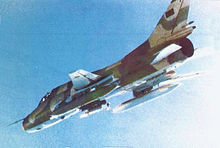
Libyan Su-22M-3K
Administration breakdown
The largest cities (as of 2007) are Tripoli, population 1,780,000; Benghazi, population 650,629; Misrata, population 386,120; al-Aziziyya, population 287,407; Tarhuna, population 210,697; and al-Chums, population 201,943.
See also: List of cities in Libya
Current outline
The classic three regions of Libya are Tripolitania, Fezzan and Cyrenaika. Libya was divided in this form until 1963. In 1928, the Italian colonizers counted 596,000 people in Tripolitania and 195,000 in Cyrenaika; Fezzan was partially administered by France and Great Britain at the time and was not counted separately. According to 2004 data, 63.7% of the country's inhabitants lived in Tripolitania, 7.8% in Fezzan, and 28.5% in Cyrenaika.
In 2007, the last territorial reform took place, in which the 32 shaʿbiyyat / شعبيات / šaʿbīyāt / 'municipalities' (singular: شعبية, DMG šaʿbīya 'municipality') were replaced by 22 shaʿbiyyat.
| شعبية | Shaʿbiyya 2007 | Inhabitants 2006 | Digit | Main site | Predecessor |
| البطنان | al-Butnan | 159.536 | 1 | Tobruk | identical |
| درنة | Darna | 163.351 | 2 | Darna | Darna and al-Quba |
| الجبل الاخضر | al-Jabal al-Akhdar | 203.156 | 3 | al-Baida | identical |
| المرج | al-Mardj | 185.848 | 4 | al-Mardj | identical |
| بنغازي | Benghazi | 670.797 | 5 | Benghazi | Benghazi andal-Hizam |
| الواحات | al-Wahat | 177.047 | 6 | Ajdabiya | al-Wahat, |
| الكفرة | al-Kufra | 50.104 | 7 | al-Jauf | Northern strip ceded to |
| سرت | Surt | 141.378 | 8 | Surt | Western territories ceded to |
| مرزق | Murzuq | 78.621 | 22 | Murzuk | Northeast region ceded to |
| سبها | Sabha | 134.162 | 19 | Sabha | identical |
| وادي الحياة | Wadi al-Haya | 76.858 | 20 | Awbari | Quasi identical |
| مصراتة | Misrata | 550.938 | 9 | Misrata | Bani Walid and Misrata |
| المرقب | al-Murgub | 432.202 | 10 | al-Chums | Tarhuna Wa Msalataand |
| طرابلس | Tripoli | 1.065.405 | 11 | Tripoli | Munizip Tajura' wa-n-Nawahi al-Arbaʿand |
| الجفارة | al-Jifara | 453.198 | 12 | al-'Azīziyah | |
| الزاوية | az-Zawiya | 290.993 | 13 | az-Zawiya | az-Zawiya, |
| النقاط الخمس | an-Nuqat al-Chams | 287.662 | 14 | Zuwara | identical |
| الجبل الغربي | al-Jabal al-Gharbi | 304.159 | 15 | Gharyan | Mizda, Gharyanand |
| نالوت | Nalut | 93.224 | 16 | Nalut | Nalut and Ghadames |
| غات | Ghat | 23.518 | 21 | Ghat | identical |
| الجفرة | al-Jufra | 52.342 | 17 | Hon | Territorial gains ofSurt |
| وادي الشاطئ | Wadi ash-Shati' municipality | 78.532 | 18 | Adiri | identical |
See also: ISO 3166-2:LY
Breakdown 2001-2007
Until 2007, there were 32 municipios in Libya. The Arabic term for a Libyan administrative unit is Sha'biya (plural: Sha'biyat, English: Popularate). Until 1983, Libya was divided into ten governorates; since then, territorial reforms have taken place very often, such as
- 1983: Division into 46 districts
- 1987: Division into 25 Baladiya
- 1995: Division into 13 Baladiya
- 1999: Division into 26 shabiya
- 2001: Division into 32 Shabiya
- 2007: Division into 22 Shabiya
| No. | شعبية | Shabiya | Inhabitants2003 | Surface km² |
| 1 | إجدابيا | Ajdabiya | 165.839 | 91.620 |
| 2 | البطنان | al-Butnan | 144.527 | 83.860 |
| 3 | الحزام الاخضر | al-Hizam al-Akhdar | 108.860 | 12.800 |
| 4 | الجبل الاخضر | al-Jabal al-Akhdar | 194.185 | 7.800 |
| 5 | الجفارة | al-Jifara | 289.340 | 1.940 |
| 6 | الجفرة | al-Jufra | 45.117 | 117.410 |
| 7 | الكفرة | al-Kufra | 51.433 | 483.510 |
| 8 | المرج | el Merdj | 116.318 | 10.000 |
| 9 | المرقب | Municipality of al-Murgub | 328.292 | 3.000 |
| 10 | النقاط الخمس | an-Nuqat al-Chams | 208.954 | 5.250 |
| 11 | القبة | Gubba | 93.895 | 14.722 |
| 12 | الواحات | al-Wahat | 29.257 | 108.670 |
| 13 | الزاوية | az-Zawiya | 197.177 | 1.520 |
| 14 | بنغازي | Benghazi | 636.992 | 800 |
| 15 | بنى وليد | Bani Walid | 77.424 | 19.710 |
| 16 | درنة | Darnah | 81.174 | 4.908 |
| 17 | غات | Ghat | 22.770 | 72.700 |
| 18 | غدامس | Ghadames | 19.000 | 51.750 |
| 19 | غريان | Gharyan | 161.408 | 4.660 |
| 20 | مرزق | Murzuq | 68.718 | 349.790 |
| 21 | مزدة | Mizda | 41.476 | 72.180 |
| 22 | مصراتة | Misratah | 360.521 | 2.770 |
| 23 | نالوت | Nalut | 86.801 | 13.300 |
| 24 | تاجوراء والنواحي الأربع | Munizip Tajura' wa-n-Nawahi al-Arbaʿ | 267.031 | 1.430 |
| 25 | ترهونة و مسلاته | Tarhuna Wa Msalata | 296.092 | 5.840 |
| 26 | طرابلس | Tarabulus | 882.926 | 400 |
| 27 | سبها | Sabha | 126.610 | 15.330 |
| 28 | سرت | Surt | 156.389 | 77.660 |
| 29 | صبراته و صرمان | Sabratha Wa Surman | 152.521 | 1.370 |
| 30 | وادي الحياة | Wadi al-Haya | 72.587 | 31.890 |
| 31 | وادي الشاطئ | Wadi ash-Shati' municipality | 77.203 | 97.160 |
| 32 | يفرن | Yafran | 117.647 | 9.310 |
|
| ليبيا | Libya | 5.678.484 | 1.775.060 |

Tripartition of Libya after World War II and during the UN Trusteeship (1943/47-1951).
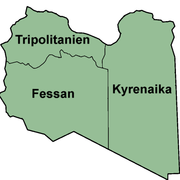
The three historical governorates of Libya (1951-1963).
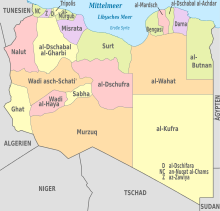
Current administrative division of Libya (22 shaʿbiyyat; since 2007)
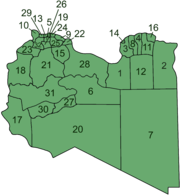
Administrative Structure in Libya 2001-2007
Economy
The Libyan economy was strongly characterized by planned economic elements with import bans, price controls and state-controlled distribution. Since the revolution in 1969, sociopolitical measures have been taken, including subsidies for basic foodstuffs, electricity, gasoline and gas, housing construction programs, an increase in minimum wages and, since 1973, employee participation in corporate profits. Since 1992, however, nationalized real estate has been privatized again. As a result of these social policy measures, Libya was the country with the lowest wealth disparity in Africa. The education sector was built up; school attendance is compulsory from age 6 to 15, and school attendance is free.
Beginning in 2002, the Libyan government under Muammar al-Gaddafi pursued a cautious course of liberalization, which was reflected in a marked increase in growth. Since 2003, real economic growth has regularly exceeded 5 %. In 2005, real growth was 6.3 %, preliminary growth in 2006 was reported at 5.6 %, 9.2 % was estimated for 2007 and 8.8 % was expected for 2008. Not least, the significant increase in the price of oil allowed the government to accelerate reforms. Libya's first stock exchange opened in Benghazi at the end of March 2007. The government privatized the state-owned Sahara Bank and decided on further privatization measures in the economy. In 2007, however, Libya was among the most corrupt countries in the world (ranked 146 out of 178 according to the Corruption Perceptions Index in 2010) on a par with Cameroon, Côte d'Ivoire, Haiti, Iran, Nepal, Paraguay and Yemen. Libya was the richest country in Africa toward the end of the Gaddafi era, but since the start of the uprisings and the ensuing civil war, per capita GDP has halved.
In Transparency International's Corruption Perceptions Index (CPI), the country ranked 170th out of 176 countries, along with Sudan and Yemen (as of 2016).
Since the country has rich oil reserves, 70 % of GDP in 2005 was generated by oil and natural gas. Accordingly, all other economic sectors played a subordinate role: agriculture 2.9 %, mining 0.8 %, manufacturing 1.4 %, electricity, gas, water 0.7 %, construction 3.3 %, trade, hotels and restaurants 5.3 %, transport, storage and communications 3.7 %, public services 8.6 %.
The unemployment rate was reported at 30% in 2004. The inflation rate was 10.4 % in 2008 and 2.0 % in 2009. With a human development index of 0.784, Libya (even after the start of the civil war in 2011) is considered the most developed state on the African continent, according to the United Nations.
After the Libyan revolution in 2011 and the fall of the Gaddafi regime, the newly elected transitional government planned to introduce Sharia law by 2015. Accordingly, interest rates were to be banned. On October 12, 2013, pro-government militias kidnapped Prime Minister Ali Seidan in a dispute over the distribution of financial resources in Libya.
Libya ranks 134th out of 137 countries in the Global Competitiveness Index, which measures a country's competitiveness (as of 2017-2018).
Agriculture
In the few agriculturally viable areas along the coast, the main crops are wheat, barley, vegetables, olives, almonds, citrus fruits and dates. Despite the small agricultural area, Libya's date cultivation accounts for 2-5% of world production. Olive cultivation also accounts for 1-3% of world production (as of 2006). As early as the 2000s, the government forced the irrigation of fields in the desert, which many environmental groups criticize as environmentally harmful.
Industry
Libya has the largest oil reserves in Africa. Therefore, Libya's largely nationalized economy is based on its rich oil and natural gas reserves.
The largest cement factories in Libya are those of LCC and ACC. After the end of the US embargo in 2004, branches of ABB, Siemens and other international companies were reopened in Libya. Due to oil production, there are numerous refineries, especially in the coastal areas. There are also textile and food industries.
In August 2013, oil production in Libya fell to an estimated low of 300,000 barrels of oil per day.
Foreign Trade
Exports in 2010 were $41.9 billion, according to the CIA Factbook (to Italy 32%, People's Republic of China 9%, Spain 9%, Germany 8%, and U.S. 5%). Under the brand name Tamoil, Libya operates its own refineries and eponymous gas station networks in Germany, Italy, and Switzerland. Other industry is limited to the chemical, textile, furniture and building materials sectors.
Imports (from Italy 16.3%, China 10.3%, Turkey 10%, France 6.8%, Germany 6%, Egypt 6%, Republic of Korea 6%, and Tunisia 4%) totaled $24.3 billion worth of machinery, food, iron and steel, and motor vehicles.
Tourism
Due to political isolation in the past, tourism is insignificant but has great potential. Previously sparsely visited tourist destinations such as the ancient cities of Leptis Magna, Sabrata and Cyrene, famous oasis cities such as Ghadames, and many Mesolithic rock paintings in the southern desert could benefit from the country's recent political opening.
State budget
In 2016, the national budget comprised expenditures of the equivalent of $13.7 billion, offset by revenues of the equivalent of $5.8 billion. This resulted in a budget deficit of 23.8% of GDP. In relation to economic output, the budget deficit was thus the highest in the world. Libya still had foreign exchange reserves of $70 billion in December 2015.
The national debt in 2009 was $4 billion, or 6.5% of GDP.
In 2006, the share of government spending (as a % of GDP) of the following areas was:
- Healthcare system: 2.4
- Education system: 2.7 % (1999)
- Military: 3.9 % (2005)
On January 30, 2012, the IMF warned that the government's finances are in a "dangerous" state. There is a $10 billion deficit in the 2012 budget, and the government is struggling to pay salaries and energy bills. According to the chairman of the Transitional Council, oil revenues in the previous five months amounted to only $5 billion, but the cost of salaries and energy amounts to $14 billion per year. Of the $100 billion frozen and released by the sanctions, only $6 billion is back in the country, he said; they are working to get the rest as well. At the same time, organizational structures are being prepared with local councils so that public employees can be paid as soon as the money arrives. This process is expected to be completed by February 17, 2012.
On February 6, 2012, it became known that several million dollars from the Gaddafi family's frozen assets, which have since been unfrozen, were stolen by corrupt officials of the new government and smuggled out of the country in suitcases through ports. Finance Minister Hassan Siglam threatened to resign unless the government either took control of the ports or suspended the return of the frozen funds.
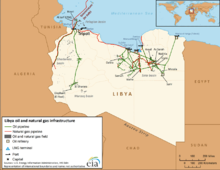
Oil and gas deposits, pipelines and refineries
Infrastructure
Traffic
Libya has ports in Tobruk (natural harbor), Tripoli, Benghazi, Misurata, Mersa Brega, and several oil shipping ports.
The international airports are Tripoli International Airport, Mitiga Airport and Benghazi Airport.
With about 47,600 km of paved roads and about 35,600 km of dirt roads, the country has a comparatively very good infrastructure for the region.
Two existing narrow-gauge lines in Tripoli and Benghazi were closed in 1965. Currently, a completely new standard-gauge rail network is being built in Libya, which in the long term is to close the gap in the North African rail network between Tunisia and Egypt near the coast. Initially, the section between Sirte and Benghazi will be built as a double-track line on which diesel-powered trains will initially run; later, the line will be electrified. The line is to be equipped with ETCS. In addition to the coastal railroad, an almost 1,000 km long line is being built in the direction of Niger.
Libya had the highest number of traffic fatalities relative to population in the world in 2013.
See also: Rail transport in Libya
Irrigation
In 1984, Libya began the systematic extraction of glacial freshwater resources in the Sahara. The Great Man-Made River Project was the largest freshwater project in the world to date. In this way, the country hopes not only to become independent of food imports, but also to become an agricultural exporting state. According to Gaddafi, there is no alternative to the GMMR project for supplying the population with drinking water. However, the medium-term cost development is questionable in view of the enormous construction and maintenance costs. What is indisputable is that the GMMR project represents a huge educational and infrastructural measure and ensures Libya's economic stability after the oil wells dry up, although it remains uncertain to this day how large the underground freshwater reserves are and thus how long the project will last and how well it will function. However, with the fall of Gaddafi and the takeover of power by the rebels in 2011, the continuation of this policy is now questionable.
Nuclear program
In the 1970s, Libya wanted to buy a reactor from the Soviet Union and have the Sirt nuclear power plant built. However, the plans were halted.
Subsequently, Libya also worked on developing its own nuclear (weapons) technology. In 2004, Abdul Kadir Khan, the "father of the Islamic atomic bomb" and chief developer of Pakistan's nuclear weapons program, confessed to Pakistani intelligence that he had also supplied Libya with secret nuclear weapons plans in the past.
After Libyan leader Gadhafi declared the country's renunciation of weapons of mass destruction in December 2003, Libya granted the International Atomic Energy Agency comprehensive control over the country's nuclear facilities by signing the so-called Additional Protocol to the Nuclear Non-Proliferation Treaty on March 10, 2004.
In July 2007, Gaddafi and then-French President Nicolas Sarkozy signed a memorandum of understanding on the construction of a nuclear power plant.
Telecommunications
The telecommunications sector is primarily under the control of the state-owned General Posts and Telecommunications Company (GPTC), which was founded in 1984 and was run by Gaddafi's eldest son Mohammed until the outbreak of the civil war.
The number of fixed-network lines in the country rose from 105,000 lines in 1974 to 1.28 million in 2009. The two largest cities, Tripoli and Benghazi, have been connected by submarine cable since 1971, and in 1999 Alcatel installed a fiber-optic cable connection along the coast between Zuwara and Tobruk. There are also international connections to Italy, Malta and France, as well as a direct telephone link to Tunisia. A planned submarine cable between Libya and Greece was scheduled for 2011, but completion of the project was delayed due to the civil war, with completion then taking place in January 2013.
A mobile network has existed in the country since 1997. In 2009, the country had 10.9 million users, distributed between the two companies al-Madar and Libyana. When the government cut off connections to the east of the country at the beginning of the uprisings in February 2011, activists took over parts of the Libyana network in April 2011 and founded their own company, which they called Libyana al Hura (Free Libyana).
The number of Internet users was reported at 353,900 in 2009; Libya Telecom and Technology (LTT), a subsidiary of the GPTC founded in 1997, is the country's only Internet provider. During the civil war, there were repeated disruptions and outages; only after the capture of Tripoli were all connections restored, but due to the destroyed infrastructure and increasing usage, speeds remained very low. The 2011 State of the Internet report published by Akamai ranked Libya as the country with the slowest Internet access in the world. In July 2012, the government decided to open the Internet market to private companies. This is intended to end the monopoly of the state-owned LTT. In 2016, 21.1% of the population used the Internet.
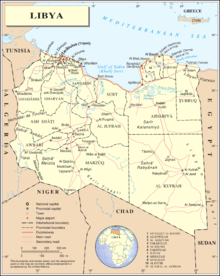
Libya infrastructure
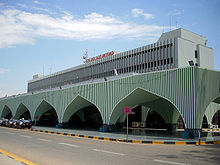
Tripoli Airport
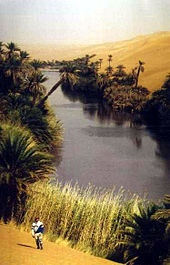
Lake Umm al-Maʾ in Libya
Questions and Answers
Q: What is the official name of Libya?
A: The official name of Libya is the State of Libya.
Q: Where is Libya located?
A: Libya is located in North Africa.
Q: What countries border Libya?
A: The countries that border Libya are Egypt to the east, Sudan to the southeast, Chad and Niger to the south, Algeria and Tunisia to the west.
Q: How large is Libya?
A: Libya covers an area of almost 1.8 million square kilometres (700,000 sq mi). It is the 17th largest country in the world.
Q: What language do people speak in Libya?
A: People in Libya primarily speak Arabic and Berber.
Q: What body of water borders Libya to the north?
A: The Mediterranean Sea borders Libya to the north.
Search within the encyclopedia